UAV-Based Multitemporal Remote Sensing Surveys of Volcano Unstable Flanks: A Case Study from Stromboli
Abstract
:1. Introduction
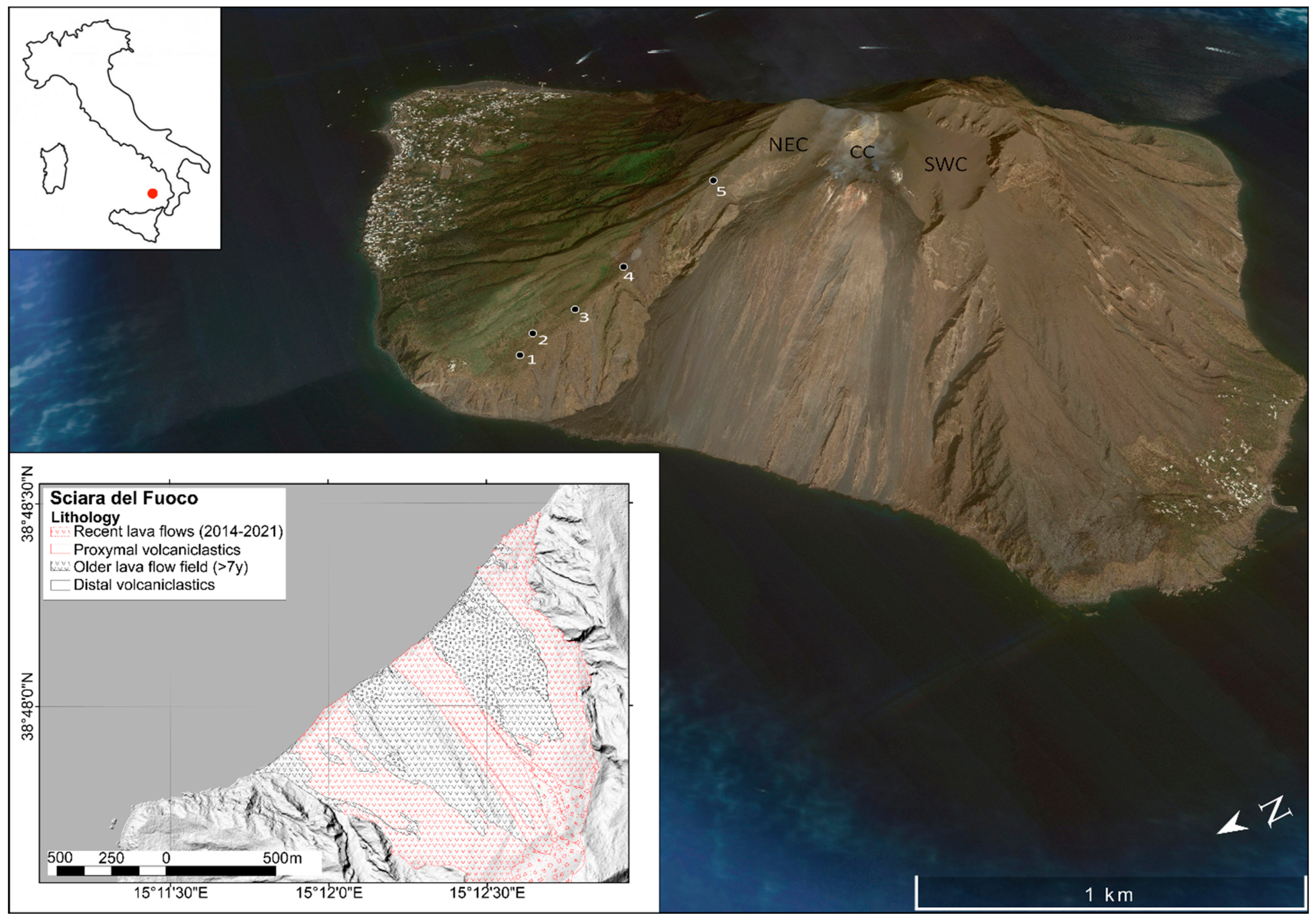
2. Materials and Methods
- The number of planned flights has gone from a minimum of 4 to a maximum of 7 flights to cover the entire area of interest. These were performed by acquiring strips parallel to the slope, at a variable height, and with nadiral grip geometry. The increase in flights has made it possible to raise the number of frames and, therefore, the accuracy of the products.
- The 5 take-off points used in the first reliefs placed at an increasing altitude on the NE side of the Sciara del Fuoco have been replaced by a unique starting point located at an altitude of 190 m above sea level (take-off number 1 in Figure 1). The single take-off point considerably reduced acquisition times and the risk exposure of operators.
- GNSS systems campaigns on the ground with RTK correction, aimed at measuring the coordinates of control points (Ground Control Points (GCPs)), were carried out during each drone survey. GCPs were materialized on the ground with specific targets recognizable on aerial photos and necessary for the georeferencing of three-dimensional models. The shape, color, and material of the targets were modified during the surveys to understand which was the most recognizable from the frames and therefore returned better accuracy and precision. Among those used previously, the targets used in December 2018 and June 2019 of square shape (20 × 20 cm), orange color, and with a black central circle with a diameter of 5 cm were the most appropriate.
3. Results
3.1. April 2017 to June 2019 DEMs Comparison
3.2. Application on July 2021 DEM
3.3. Small-Scale Detailed Analysis
4. Discussion and Conclusive Remarks
- Positioning of GCPs alongside the perimeter of the inaccessible area.
- Drone multitemporal surveys using physical shutter cameras and lenses with a field of view of less than 80° to minimize rolling shutter and lens distortions; on-board submetric GNSS or in any case capable of Horizontal Dilution of Point (HDOP) < 1 m.
- Anchoring of point clouds to virtual GCPs exported from a previous LiDAR survey carried out in 2012 located along the unreachable portions of the Sciara del Fuoco.
- Georeferencing using GCPs obtained from GNSS measurements of the June 2019 survey positioned along the trails or in any case in areas that have not undergone changes and are easily recognizable from the frames acquired over the years.
- Georeferencing refinement by realigning the point clouds with respect to a reference point cloud (Stromboli 6).
Author Contributions
Funding
Conflicts of Interest
References
- Francioni, M.; Salvini, R.; Stead, D.; Coggan, J. Improvements in the integration of remote sensing and rock slope modelling. Nat. Hazards 2018, 90, 975–1004. [Google Scholar] [CrossRef] [Green Version]
- Gomez, C.; Kato, A. Multi-scale voxel-based algorithm for UAV-derived point-clouds of complex surfaces. In Proceedings of the 2014 IEEE International Conference on Aerospace Electronics and Remote Sensing Technology, Yogyakarta, Indonesia, 13–14 November 2014; pp. 205–209. [Google Scholar]
- Mandirola, M.; Casarotti, C.; Peloso, S.; Lanese, I.; Brunesi, E.; Senaldi, I.; Federico, R.; Monti, A.; Facchetti, C. Guidelines for the use of Unmanned Aerial Systems for fast photogrammetry-oriented mapping in emergency response scenarios. Int. J. Disaster Risk Reduct. 2021, 58, 102207. [Google Scholar] [CrossRef]
- Casagli, N.; Frodella, W.; Morelli, S.; Tofani, V.; Ciampalini, A.; Intrieri, E.; Raspini, F.; Rossi, G.; Tanteri, L.; Lu, P. Spaceborne, UAV and ground-based remote sensing techniques for landslide mapping, monitoring and early warning. Geoenviron. Disasters 2017, 4, 9. [Google Scholar] [CrossRef]
- Garnica-Peña, R.J.; Alcántara-Ayala, I. The use of UAVs for landslide disaster risk research and disaster risk management: A literature review. J. Mt. Sci. 2021, 18, 482–498. [Google Scholar] [CrossRef]
- Giordan, D.; Manconi, A.; Facello, A.; Baldo, M.; Allasia, P.; Dutto, F. Brief Communication: The use of an unmanned aerial vehicle in a rockfall emergency scenario. Nat. Hazards Earth Syst. Sci. 2015, 15, 163–169. [Google Scholar] [CrossRef] [Green Version]
- Suh, J.; Choi, Y. Mapping hazardous mining-induced sinkhole subsidence using unmanned aerial vehicle (drone) photogrammetry. Environ. Earth Sci. 2017, 76, 144. [Google Scholar] [CrossRef]
- Dominici, D.; Alicandro, M.; Massimi, V. UAV photogrammetry in the post-earthquake scenario: Case studies in L’Aquila. Geomat. Nat. Hazards Risk 2017, 8, 87–103. [Google Scholar] [CrossRef] [Green Version]
- Meyer, D.; Hess, M.; Lo, E.; Wittich, C.E.; Hutchinson, T.C.; Kuester, F. UAV-based post disaster assessment of cultural heritage sites following the 2014 South Napa Earthquake. In Proceedings of the 2015 Digital Heritage, Granada, Spain, 28 September–2 October 2015; Volume 2, pp. 421–424. [Google Scholar]
- Stepinac, M.; Gašparović, M. A review of emerging technologies for an assessment of safety and seismic vulnerability and damage detection of existing masonry structures. Appl. Sci. 2020, 10, 5060. [Google Scholar] [CrossRef]
- Zhou, J.P.; Gong, J.H.; Wang, T.; Wang, D.C.; Yang, L.Y.; Zhao, X.J.; Yu, H.; Zhao, Z.M. Study on UAV Remote Sensing Image Acquiring and Visualization Management System for the Area Affected by 5.12 Wenchuan Earthquake. J. Remote Sens. 2008, 6, 877–884. [Google Scholar]
- Daud, S.M.S.M.; Yusof, M.Y.P.M.; Heo, C.C.; Khoo, L.S.; Singh, M.K.C.; Mahmood, M.S.; Nawawi, H. Applications of drone in disaster management: A scoping review. Sci. Justice 2022, 62, 30–42. [Google Scholar] [CrossRef]
- Nakano, T.; Kamiya, I.; Tobita, M.; Iwahashi, J.; Nakajima, H. Landform monitoring in active volcano by UAV and SFM-MVS technique. Int. Arch. Photogramm. Remote Sens. Spat. Inf. Sci. 2014, 40, 71. [Google Scholar] [CrossRef] [Green Version]
- Albino, F.; Smets, B.; d’Oreye, N.; Kervyn, F. High-resolution TanDEM-X DEM: An accurate method to estimate lava flow volumes at Nyamulagira Volcano (DR Congo). J. Geophys. Res.: Solid Earth 2015, 120, 4189–4207. [Google Scholar] [CrossRef] [Green Version]
- De Beni, E.; Cantarero, M.; Messina, A. UAVs for volcano monitoring: A new approach applied on an active lava flow on Mt. Etna (Italy), during the 27 February–02 March 2017 eruption. J. Volcanol. Geotherm. Res. 2018, 369, 250–262. [Google Scholar] [CrossRef]
- Favalli, M.; Fornaciai, A.; Nannipieri, L.; Harris, A.; Calvari, S.; Lormand, C. UAV-based remote sensing surveys of lava flow fields: A case study from Etna’s 1974 channel-fed lava flows. Bull. Volcanol. 2018, 80, 29. [Google Scholar] [CrossRef]
- Civico, R.; Ricci, T.; Scarlato, P.; Andronico, D.; Cantarero, M.; Carr, B.B.; De Beni, E.; Del Bello, E.; Johnson, J.B.; Kueppers, U.; et al. Unoccupied Aircraft Systems (UASs) Reveal the Morphological Changes at Stromboli Volcano (Italy) before, between, and after the 3 July and 28 August 2019 Paroxysmal Eruptions. Remote Sens. 2021, 13, 2870. [Google Scholar] [CrossRef]
- Turner, N.R.; Perroy, R.L.; Hon, K. Lava flow hazard prediction and monitoring with UAS: A case study from the 2014–2015 Pāhoa lava flow crisis, Hawai ‘i. J. Appl. Volcanol. 2017, 6, 17. [Google Scholar] [CrossRef] [Green Version]
- Rokhmana, C.A.; Andaru, R. Utilizing UAV-based mapping in post disaster volcano eruption. In Proceedings of the 2016 6th International Annual Engineering Seminar (InAES), Yogyakarta, Indonesia, 1–3 August 2016; pp. 202–205. [Google Scholar]
- Darmawan, H.; Walter, T.R.; Troll, V.R.; Budi-Santoso, A. Dome instability at Merapi volcano identified by drone photogrammetry and numerical modeling. Nat. Hazards Earth Syst. Sci. Discuss. 2018, 1–27. [Google Scholar]
- Gomez, C.; Purdie, H. UAV-based photogrammetry and geocomputing for hazards and disaster risk monitoring–a review. Geoenviron. Disasters 2016, 3, 23. [Google Scholar] [CrossRef] [Green Version]
- Marek, L.; Miřijovský, J.; Tuček, P. Monitoring of the Shallow Landslide Using UAV Photogrammetry and Geodetic Measurements. Eng. Geol. Soc. Ter. 2015, 2, 113–116. [Google Scholar]
- Niethammer, U.; James, M.R.; Rothmund, S.; Travelletti, J.; Joswig, M. UAV based remote sensing of the Super-Sauze landslide: Evaluation and results. Eng. Geol. 2012, 128, 2–11. [Google Scholar] [CrossRef]
- Gracchi, T.; Rossi, G.; Stefanelli, C.T.; Tanteri, L.; Pozzani, R.; Moretti, S. Tracking the Evolution of Riverbed Morphology on the Basis of UAV Photogrammetry. Remote Sens. 2021, 13, 829. [Google Scholar] [CrossRef]
- Rossi, G.; Tanteri, L.; Tofani, V.; Vannocci, P.; Moretti, S.; Casagli, N. Multitemporal UAV surveys for landslide mapping and characterization. Landslides 2018, 15, 1045–1052. [Google Scholar] [CrossRef] [Green Version]
- Ferrer-González, E.; Agüera-Vega, F.; Carvajal-Ramírez, F.; Martínez-Carricondo, P. UAV Photogrammetry Accuracy Assessment for Corridor Mapping Based on the Number and Distribution of Ground Control Points. Remote Sens. 2020, 12, 2447. [Google Scholar] [CrossRef]
- Agüera-Vega, F.; Carvajal-Ramírez, F.; Martínez-Carricondo, P. Assessment of photogrammetric mapping accuracy based on variation ground control points number using unmanned aerial vehicle. Meas. J. Int. Meas. Confed. 2017, 98, 221–227. [Google Scholar] [CrossRef]
- Martínez-Carricondo, P.; Agüera-Vega, F.; Carvajal-Ramírez, F.; Mesas-Carrascosa, F.J.; García-Ferrer, A.; Pérez-Porras, F.J. Assessment of UAV-photogrammetric mapping accuracy based on variation of ground control points. Int. J. Appl. Earth Obs. Geoinf. 2018, 72, 1–10. [Google Scholar] [CrossRef]
- Reshetyuk, Y.; Mårtensson, S.G. Generation of Highly Accurate Digital Elevation Models with Unmanned Aerial Vehicles. Photogramm. Rec. 2016, 31, 143–165. [Google Scholar] [CrossRef]
- Forlani, G.; Dall’Asta, E.; Diotri, F.; di Cella, U.M.; Roncella, R.; Santise, M. Quality assessment of DSMs produced from UAV flights georeferenced with on-board RTK positioning. Remote Sens. 2018, 10, 311. [Google Scholar] [CrossRef] [Green Version]
- Rabah, M.; Basiouny, M.; Ghanem, E.; Elhadary, A. Using RTK and VRS in direct geo-referencing of the UAV imagery. NRIAG J. Astron. Geophys. 2018, 7, 220–226. [Google Scholar] [CrossRef] [Green Version]
- Tomaštík, J.; Mokroš, M.; Surový, P.; Grznárová, A.; Merganič, J. UAV RTK/PPK method-An optimal solution for mapping inaccessible forested areas? Remote Sens. 2019, 11, 721. [Google Scholar] [CrossRef] [Green Version]
- Štroner, M.; Urban, R.; Seidl, J.; Reindl, T.; Brouček, J. Photogrammetry Using UAV-Mounted GNSS RTK: Georeferencing Strategies without GCPs. Remote Sens. 2021, 13, 1336. [Google Scholar] [CrossRef]
- Kokelaar, P.; & Romagnoli, C. Sector collapse, sedimentation and clast population evolution at an active island-arc volcano: Stromboli, Italy. Bull. Volcanol. 1995, 57, 240–262. [Google Scholar] [CrossRef]
- Di Traglia, F.; Bartolini, S.; Artesi, E.; Nolesini, T.; Ciampalini, A.; Lagomarsino, D.; Martì, J.; Casagli, N. Susceptibility of intrusion-related landslides at volcanic islands: The Stromboli case study. Landslides 2018, 15, 21–29. [Google Scholar] [CrossRef] [Green Version]
- Blackburn, E.A.; Wilson, L.; Sparks, R.J. Mechanisms and dynamics of strombolian activity. J. Geol. Soc. 1976, 132, 429–440. [Google Scholar] [CrossRef]
- Schaefer, L.N.; Di Traglia, F.; Chaussard, E.; Lu, Z.; Nolesini, T.; Casagli, N. Monitoring volcano slope instability with Synthetic Aperture Radar: A review and new data from Pacaya (Guatemala) and Stromboli (Italy) volcanoes. Earth-Sci. Rev. 2019, 192, 236–257. [Google Scholar] [CrossRef]
- Maramai, A.; Graziani, L.; Tinti, S. Tsunamis in the Aeolian Islands (southern Italy): A review. Mar. Geol. 2005, 215, 11–21. [Google Scholar] [CrossRef]
- Fornaciai, A.; Favalli, M.; Nannipieri, L. Numerical simulation of the tsunamis generated by the Sciara del Fuoco landslides (Stromboli Island, Italy). Sci. Rep. 2019, 9, 18542. [Google Scholar] [CrossRef] [Green Version]
- Esposti Ongaro, T.; de’Michieli Vitturi, M.; Cerminara, M.; Fornaciai, A.; Nannipieri, L.; Favalli, M.; Calusi, B.; Macìas, J.; Castro, M.J.; Ortega, S.; et al. Modeling Tsunamis Generated by Submarine Landslides at Stromboli Volcano (Aeolian Islands, Italy): A Numerical Benchmark Study. Front. Earth Sci. 2021, 9, 274. [Google Scholar] [CrossRef]
- Tinti, S.; Pagnoni, G.; Zaniboni, F. The landslides and tsunamis of the 30th of December 2002 in Stromboli analysed through numerical simulations. Bull. Volcanol. 2006, 68, 462–479. [Google Scholar] [CrossRef]
- Di Traglia, F.; Fornaciai, A.; Favalli, M.; Nolesini, T.; Casagli, N. Catching geomorphological response to volcanic activity on steep slope volcanoes using multi-platform remote sensing. Remote Sens. 2020, 12, 438. [Google Scholar] [CrossRef] [Green Version]
- Di Traglia, F.; Fornaciai, A.; Casalbore, D.; Favalli, M.; Manzella, I.; Romagnoli, C.; Chiocci, F.L.; Cole, P.; Nolesini, T.; Casagli, N. Subaerial-submarine morphological changes at Stromboli volcano (Italy) induced by the 2019–2020 eruptive activity. Geomorphology 2022, 400, 108093. [Google Scholar] [CrossRef]
- Agisoft. Agisoft Metashape User Manual Professional Edition, Version 1.7. 2019. Available online: https://www.agisoft.com/pdf/metashape-pro_1_7_en.pdf (accessed on 22 January 2021).
- CloudCompare (Version 2.11). 2020. Available online: http://www.cloudcompare.org/ (accessed on 10 April 2022).
- ESRI. ArcGIS Desktop: Version 10.7.1.; Environmental Systems Research Institute: Redlands, CA, USA, 2011. [Google Scholar]
- Plank, S.; Marchese, F.; Filizzola, C.; Pergola, N.; Neri, M.; Nolde, M.; Martinis, S. The July/August 2019 Lava Flows at the Sciara del Fuoco, Stromboli–Analysis from Multi-Sensor Infrared Satellite Imagery. Remote Sens. 2019, 11, 2879. [Google Scholar] [CrossRef] [Green Version]
- Calvari, S.; Di Traglia, F.; Ganci, G.; Giudicepietro, F.; Macedonio, G.; Cappello, A.; Nolesini, T.; Pecora, E.; Bilotta, G.; Centorrino, V.; et al. Overflows and pyroclastic density currents in March-April 2020 at Stromboli volcano detected by remote sensing and seismic monitoring data. Remote Sens. 2020, 12, 3010. [Google Scholar] [CrossRef]
- Università degli Studi di Firenze-Centro per la Protezione Civile (UNIFI-CPC, 2020a) Comunicato Sistema SAR di Stromboli del Periodo 15 Aprile 2020 ore 11. Available online: https://cme.ingv.it/bollettini-e-comunicati/comunicati-unifi-cpc-stromboli/467-2020-04-15-comunicato-sistema-sar-di-stromboli-del-periodo-15-aprile-2020-ore-11-1/file (accessed on 1 March 2020).
- Università degli Studi di Firenze-Centro per la Protezione Civile (UNIFI-CPC, 2020b) Comunicato Sistema SAR di Stromboli del Periodo 19 Aprile 2020 ore 23. Available online: https://cme.ingv.it/bollettini-e-comunicati/comunicati-unifi-cpc-stromboli/468-2020-04-19-comunicato-sistema-sar-di-stromboli-del-periodo-19-aprile-2020-ore-23-00-1/file (accessed on 1 March 2020).
- Università degli Studi di Firenze-Centro per la Protezione Civile (UNIFI-CPC, 2020c) Bollettino Sistema SAR di Stromboli del periodo 23 aprile 2020–30 aprile 2020. Available online: https://cme.ingv.it/bollettini-e-comunicati/bollettini-unifi-cpc-stromboli-1/308-2020-04-30-bollettino-sistema-sar-di-stromboli-del-periodo-23-aprile-2020-30-aprile-2020/file (accessed on 1 March 2020).
- Università degli Studi di Firenze-Centro per la Protezione Civile (UNIFI-CPC, 2021a) Bollettino Sistema SAR di Stromboli del periodo 21 Gennaio 2021–28 Gennaio 2021. Available online: https://cme.ingv.it/bollettini-e-comunicati/bollettini-unifi-cpc-stromboli-1/597-2021-01-28-bollettino-sistema-sar-di-stromboli-del-periodo-21-gennaio-2021-28-gennaio-2021/file (accessed on 1 March 2020).
- Università degli Studi di Firenze-Centro per la Protezione Civile (UNIFI-CPC, 2021b) Comunicato Sistema SAR di Stromboli del periodo 19 Maggio 2021 ore 18. Available online: https://cme.ingv.it/bollettini-e-comunicati/comunicati-unifi-cpc-stromboli/689-2021-05-19-comunicato-sistema-sar-di-stromboli-del-19-maggio-2021-ore-18/file (accessed on 1 March 2020).
- Università degli Studi di Firenze-Centro per la Protezione Civile (UNIFI-CPC, 2021c) Comunicato Sistema SAR di Stromboli del periodo 17 Giugno 2021 ore 23.15. Available online: https://cme.ingv.it/bollettini-e-comunicati/comunicati-unifi-cpc-stromboli/750-2021-06-17-comunicato-sistema-sar-di-stromboli-del-17-giugno-2021-ore-23-15/file (accessed on 1 March 2020).
- Università degli Studi di Firenze-Centro per la Protezione Civile (UNIFI-CPC, 2021d) Comunicato Sistema SAR di Stromboli del periodo 26 Novembre 2021 ore 10. Available online: https://cme.ingv.it/bollettini-e-comunicati/comunicati-unifi-cpc-stromboli/981-2021-11-26-comunicato-sistema-sar-di-stromboli-del-26-novembre-2021-ore-10-00/file (accessed on 1 March 2020).
- Baldi, P.; Fabris, M.; Marsella, M.; Monticelli, R. Monitoring the morphological evolution of the Sciara del Fuoco during the 2002–2003 Stromboli eruption using multi-temporal photogrammetry. ISPRS J. Photogramm. Remote Sens. 2005, 59, 199–211. [Google Scholar] [CrossRef]
- Marsella, M.; Baldi, P.; Coltelli, M.; Fabris, M. The morphological evolution of the Sciara del Fuoco since 1868: Reconstructing the effusive activity at Stromboli volcano. Bull. Volcanol. 2012, 74, 231–248. [Google Scholar] [CrossRef]
- Di Traglia, F.; Calvari, S.; D’Auria, L.; Nolesini, T.; Bonaccorso, A.; Fornaciai, A.; Esposito, A.; Cristaldi, A.; Favalli, M.; Casagli, N. The 2014 effusive eruption at Stromboli: New insights from in situ and remote-sensing measurements. Remote Sens. 2018, 10, 2035. [Google Scholar] [CrossRef] [Green Version]
- Kellner, J.R.; Armston, J.; Birrer, M.; Cushman, K.C.; Duncanson, L.; Eck, C.; Fallager, C.; Imbach, B.; Král, K.; Krůček, M.; et al. New opportunities for forest remote sensing through ultra-high-density drone lidar. Surv. Geophys. 2019, 40, 959–977. [Google Scholar] [CrossRef] [Green Version]
- Udin, W.S.; Ahmad, A. Assessment of photogrammetric mapping accuracy based on variation flying altitude using unmanned aerial vehicle. In Proceedings of the IOP Conference Series: Earth and Environmental Science—8th International Symposium of the Digital Earth (ISDE8), Kuching, Malaysia, 26–29 August 2013; Volume 18, p. 012027. [Google Scholar]

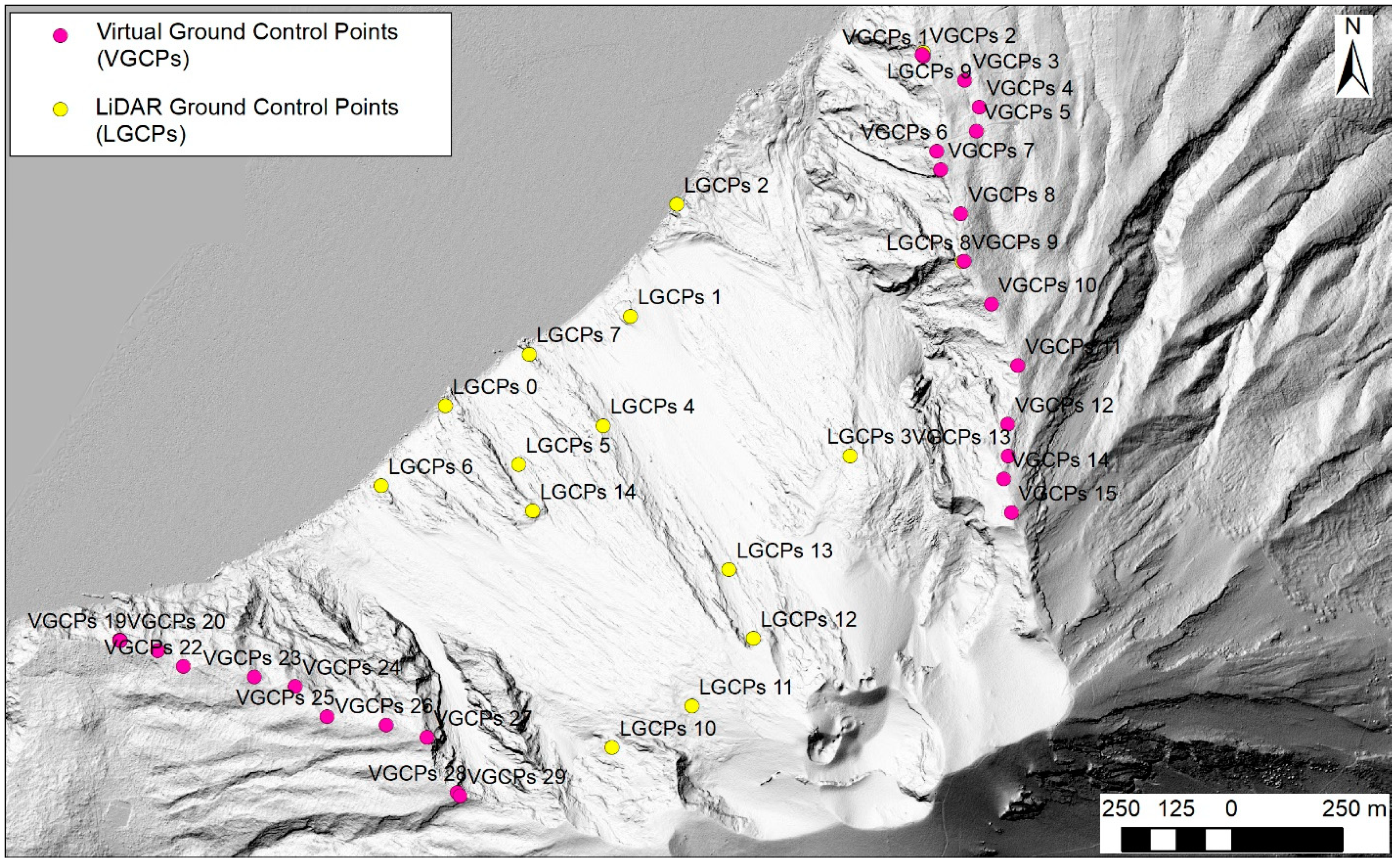
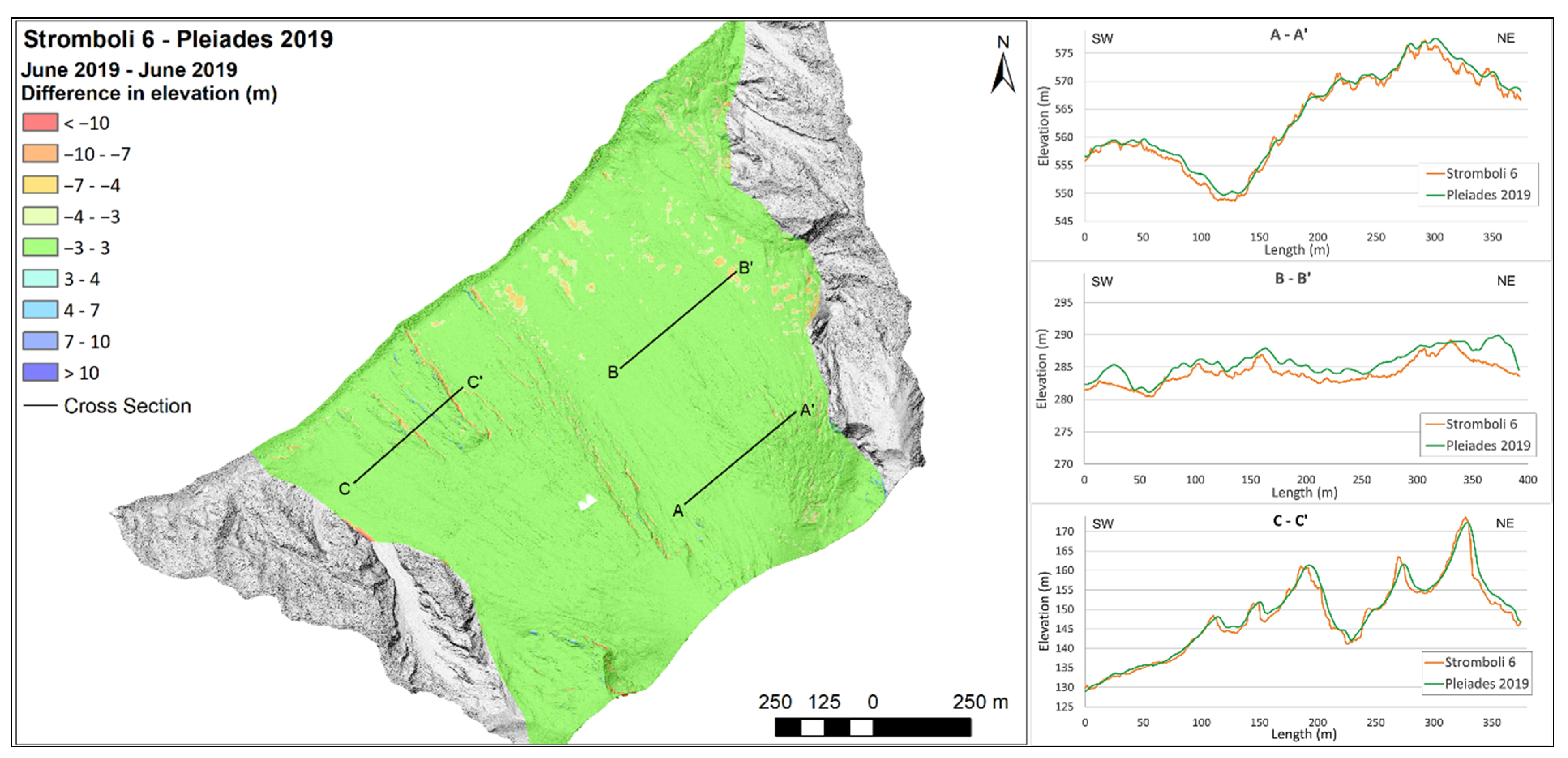

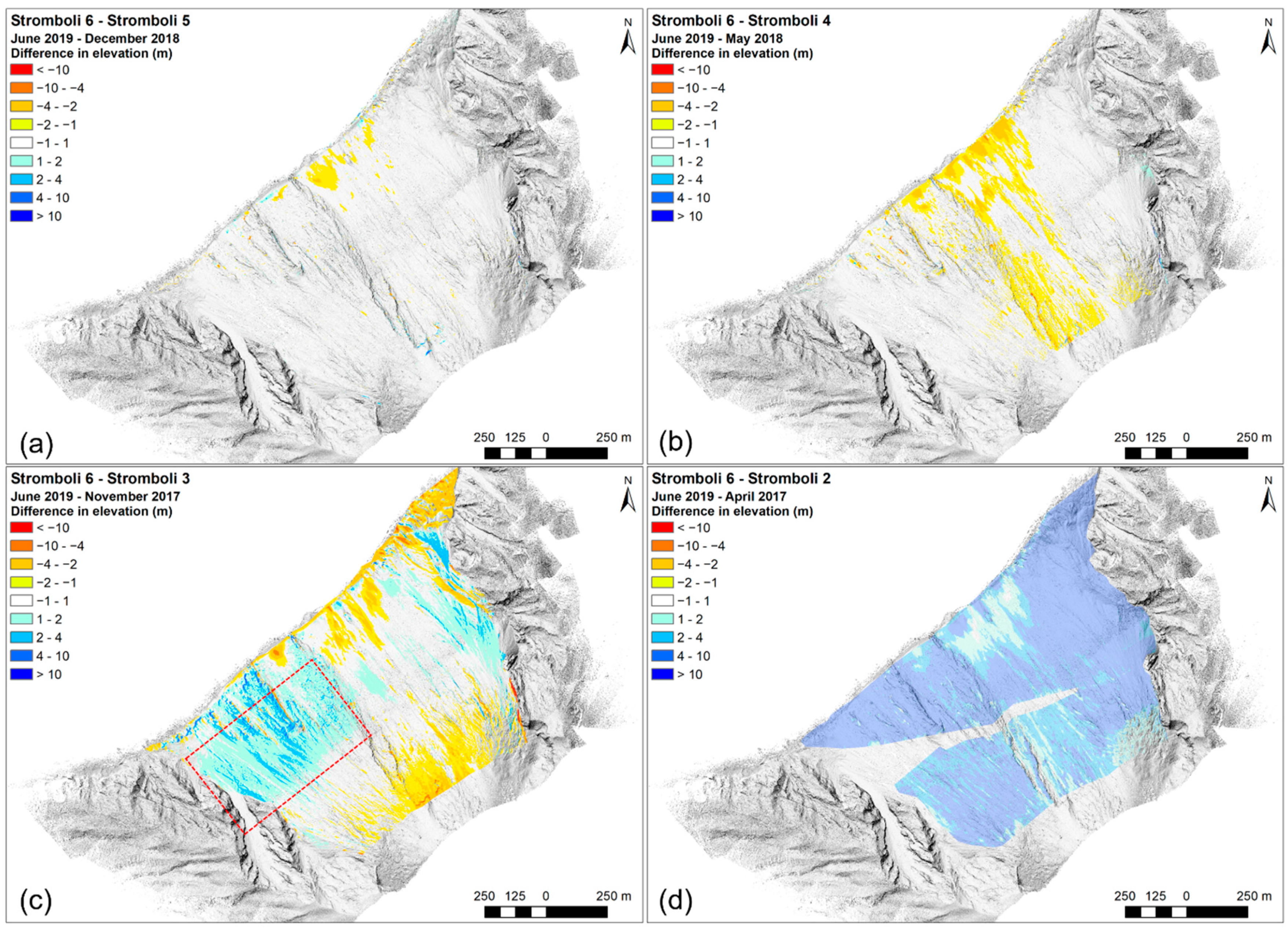
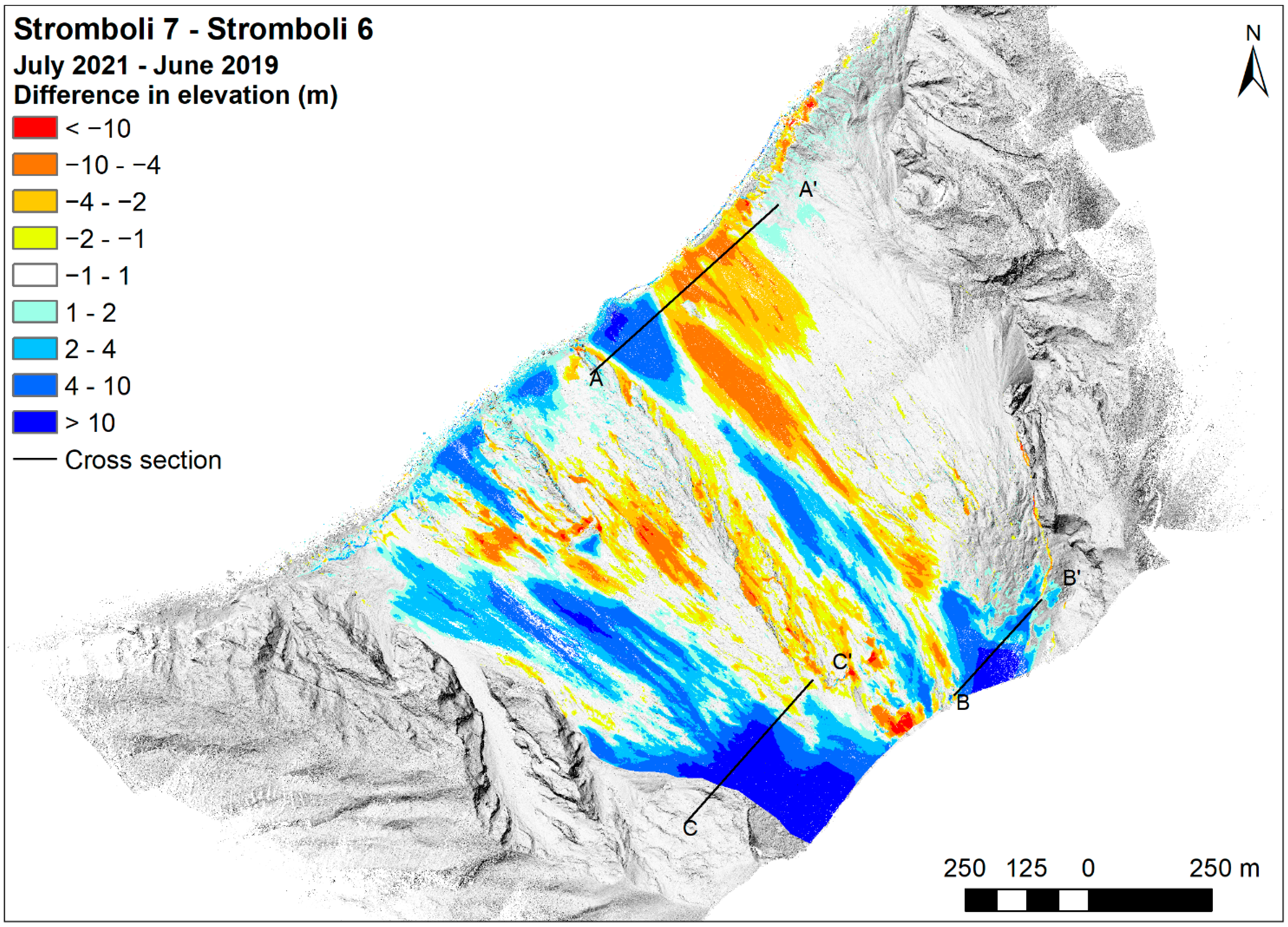
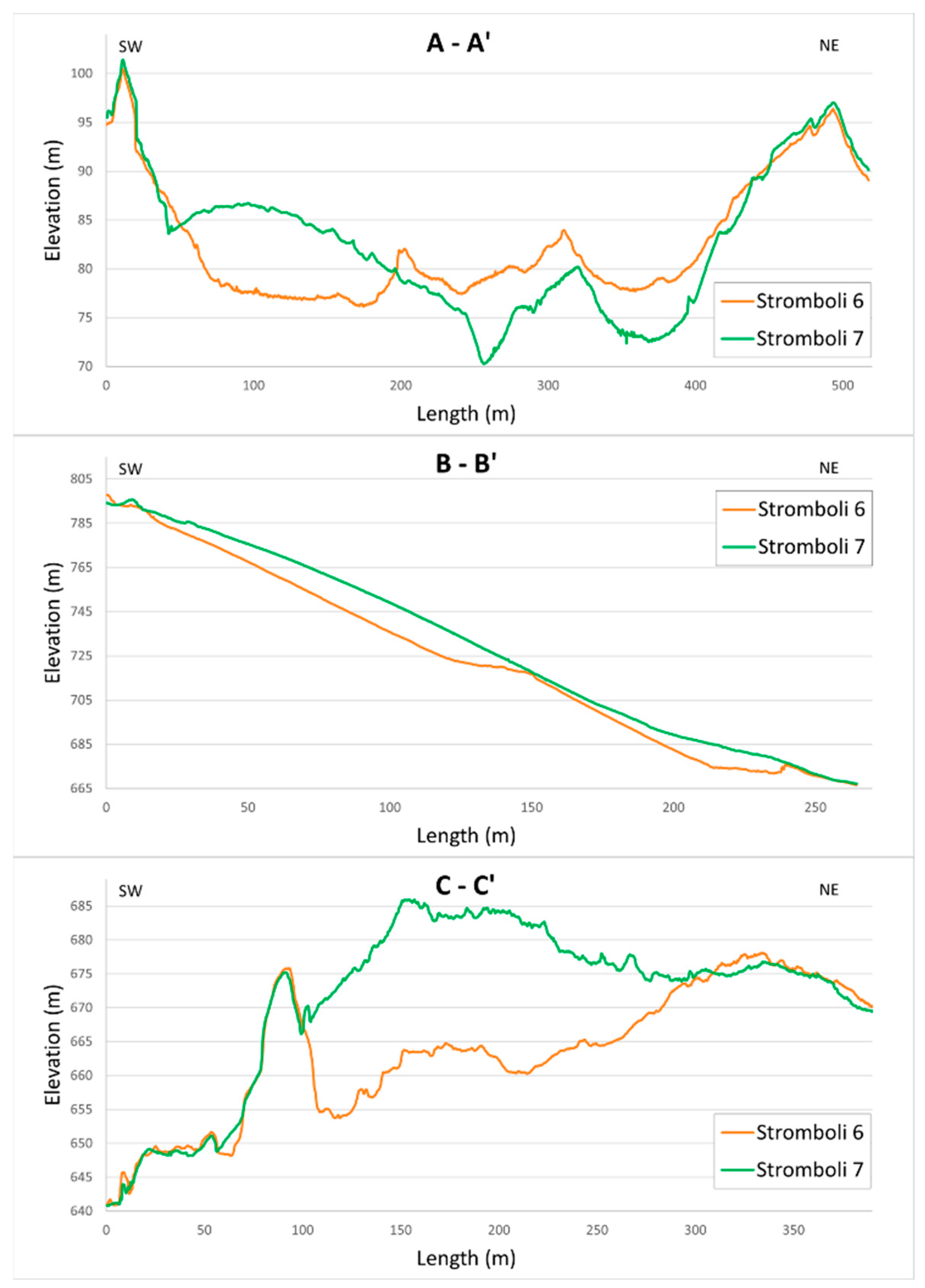
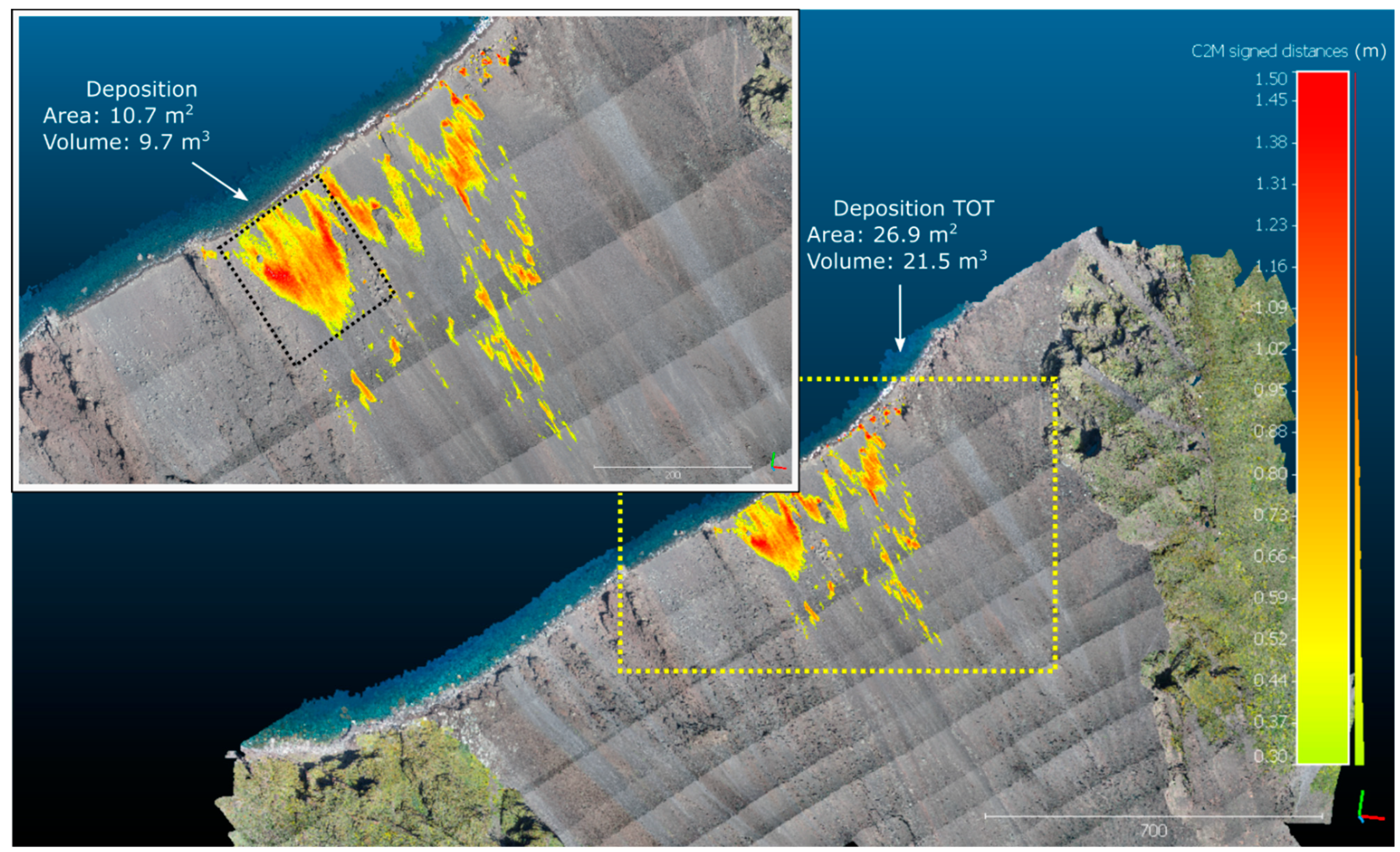
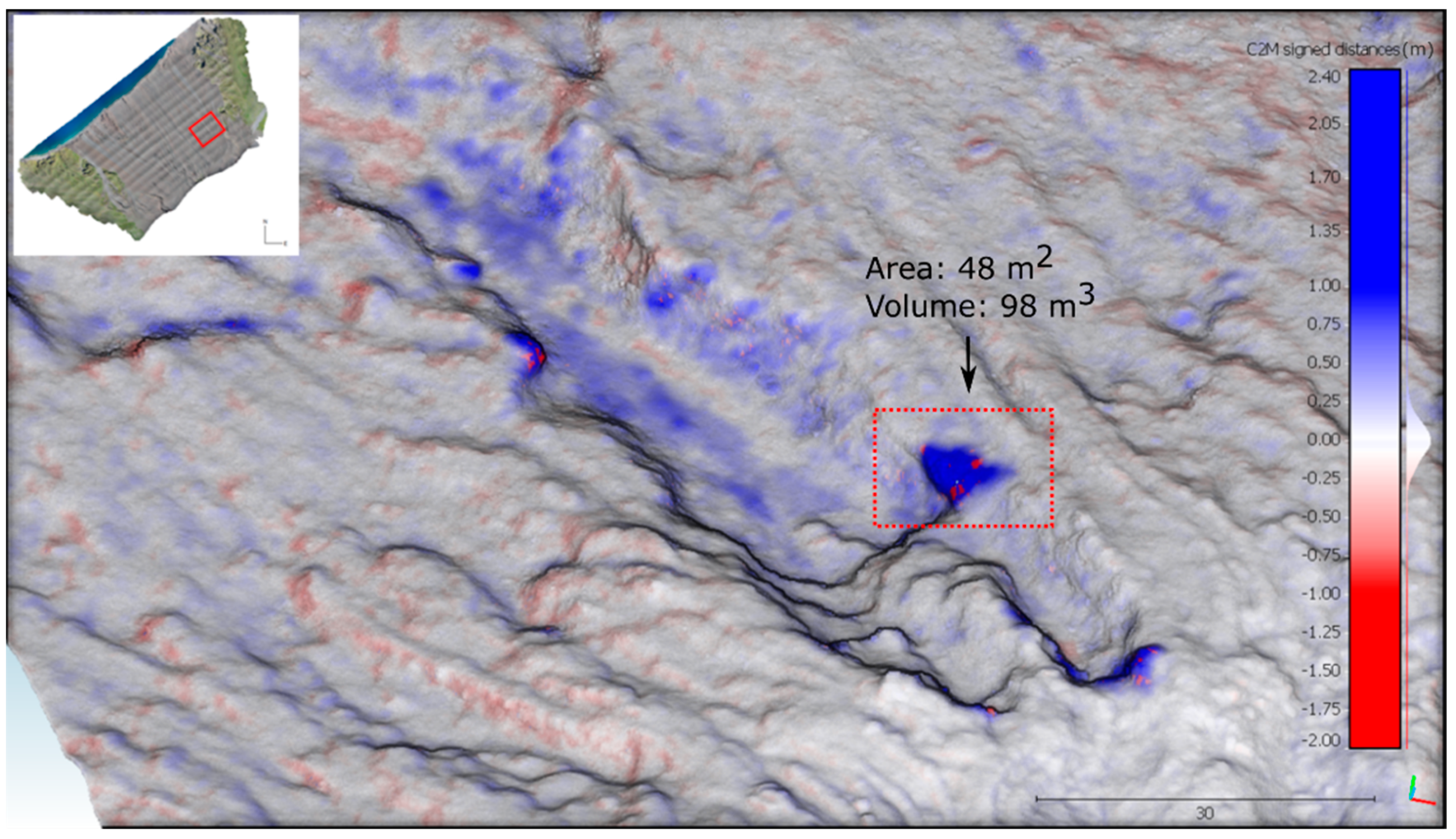
| Stromboli 1 | Stromboli 2 | Stromboli 3 | Stromboli 4 | Stromboli 5 | Stromboli 6 | |
|---|---|---|---|---|---|---|
| Date | October 2016 | April 2017 | November 2017 | May 2018 | December 2018 | June 2019 |
| Camera | Canon IXUS 240 | Canon IXUS 240 | Canon IXUS 240 | Canon IXUS 240 | Canon IXUS 160 | Canon IXUS 160 |
| Frames | 296 | 928 | 1165 | 1390 | 1512 | 1212 |
| Flight plans | 4 | 6 | 7 | 7 | 7 | 7 |
| GNSS System | - | Leica 1200 | Leica 500 | Leica 500 | EMLID REACH | EMLID REACH |
| GCPs | 0 | 17 | 16 | 31 | 32 | 29 |
| Take-off points | 5 | 5 | 3 | 2 | 1 | 1 |
| N. Points | 232′486 | 700′460 | 625′743 | 882′984 | 1′772′090 | 1′585′190 |
| DSM Resolution (cm/pix) | 10 | 9.7 | 10 | 9.5 | 7 | 6.5 |
| GCPs Average error (m) | 4.7 | 2.3 | 0.8 | 0.3 | 0.1 | 0.3 |
| Stromboli 1 | Stromboli 2 | Stromboli 3 | Stromboli 4 | Stromboli 5 | Stromboli 6 | |
|---|---|---|---|---|---|---|
| VGCPs | 27 | 19 | 21 | 29 | 29 | 29 |
| LiDAR GCPs | 3 | 13 | 14 | 5 | 15 | 15 |
| N. Points | 309′058 | 857′445 | 625′743 | 1′229′068 | 1′735′945 | 1′585′190 |
| DSM Resolution (cm/pix) | 9.8 | 9.9 | 9.6 | 10 | 7 | 6.5 |
| GCPs Average error (m) | 10.9 | 9.8 | 2.4 | 0.6 | 2.4 | 2.6 |
| Stromboli 7 | |
|---|---|
| Date | July 2021 |
| Camera | Canon IXUS 160 |
| Frames | 1102 |
| Flight plans | 7 |
| GNSS System | EMLID REACH |
| Take-off points | 1 |
| VGCPs | 29 |
| LiDAR GCPs | 15 |
| N. Points | 1′922′353′547 |
| DSM Resolution (cm/pix) | 4.8 |
| GCPs Average error (m) | 1.2 |
| Date | Event Description | Reference |
|---|---|---|
| 3 July 2019–30 August 2019 | Lava flow from SWC associated with paroxysmal explosion | Di Traglia et al., 2022 [43]; Plank et al., 2019 [47] |
| 12 July 2019 | Lava flow from NEC | Di Traglia et al., 2022 [43] |
| 18 January 2020 | Lava overflow from NEC | Di Traglia et al., 2022 [43] |
| 5 February 2020 | Lava overflow from NEC | Di Traglia et al., 2022 [43] |
| 28 February 2020 | Lava overflow from NEC | Di Traglia et al., 2022 [43]; Calvari et al., 2020 [48] |
| 28 March–1 April 2020 | Lava overflows from NEC | Di Traglia et al., 2022 [43]; Calvari et al., 2020 [48] |
| 15 April 2020 | Lava overflows from NEC | UNIFI-CPC 2020a [49] |
| 19 April 2020 | Lava overflows from NEC | UNIFI-CPC 2020b [50] |
| 24 April 2020 | Lava overflows from NEC | UNIFI-CPC 2020c [51] |
| 18–24 January 2021 | Lava overflows from NEC and major explosion | UNIFI-CPC 2021a [52] |
| 19 May 2021 | Lava flow from NEC | UNIFI-CPC 2021b [53] |
| 17 June 2021 | Lava overflows from NEC | UNIFI-CPC 2021c [54] |
| 25 November 2021 | Lava overflows from NEC | UNIFI-CPC 2021d [55] |
Publisher’s Note: MDPI stays neutral with regard to jurisdictional claims in published maps and institutional affiliations. |
© 2022 by the authors. Licensee MDPI, Basel, Switzerland. This article is an open access article distributed under the terms and conditions of the Creative Commons Attribution (CC BY) license (https://creativecommons.org/licenses/by/4.0/).
Share and Cite
Gracchi, T.; Tacconi Stefanelli, C.; Rossi, G.; Di Traglia, F.; Nolesini, T.; Tanteri, L.; Casagli, N. UAV-Based Multitemporal Remote Sensing Surveys of Volcano Unstable Flanks: A Case Study from Stromboli. Remote Sens. 2022, 14, 2489. https://doi.org/10.3390/rs14102489
Gracchi T, Tacconi Stefanelli C, Rossi G, Di Traglia F, Nolesini T, Tanteri L, Casagli N. UAV-Based Multitemporal Remote Sensing Surveys of Volcano Unstable Flanks: A Case Study from Stromboli. Remote Sensing. 2022; 14(10):2489. https://doi.org/10.3390/rs14102489
Chicago/Turabian StyleGracchi, Teresa, Carlo Tacconi Stefanelli, Guglielmo Rossi, Federico Di Traglia, Teresa Nolesini, Luca Tanteri, and Nicola Casagli. 2022. "UAV-Based Multitemporal Remote Sensing Surveys of Volcano Unstable Flanks: A Case Study from Stromboli" Remote Sensing 14, no. 10: 2489. https://doi.org/10.3390/rs14102489
APA StyleGracchi, T., Tacconi Stefanelli, C., Rossi, G., Di Traglia, F., Nolesini, T., Tanteri, L., & Casagli, N. (2022). UAV-Based Multitemporal Remote Sensing Surveys of Volcano Unstable Flanks: A Case Study from Stromboli. Remote Sensing, 14(10), 2489. https://doi.org/10.3390/rs14102489








